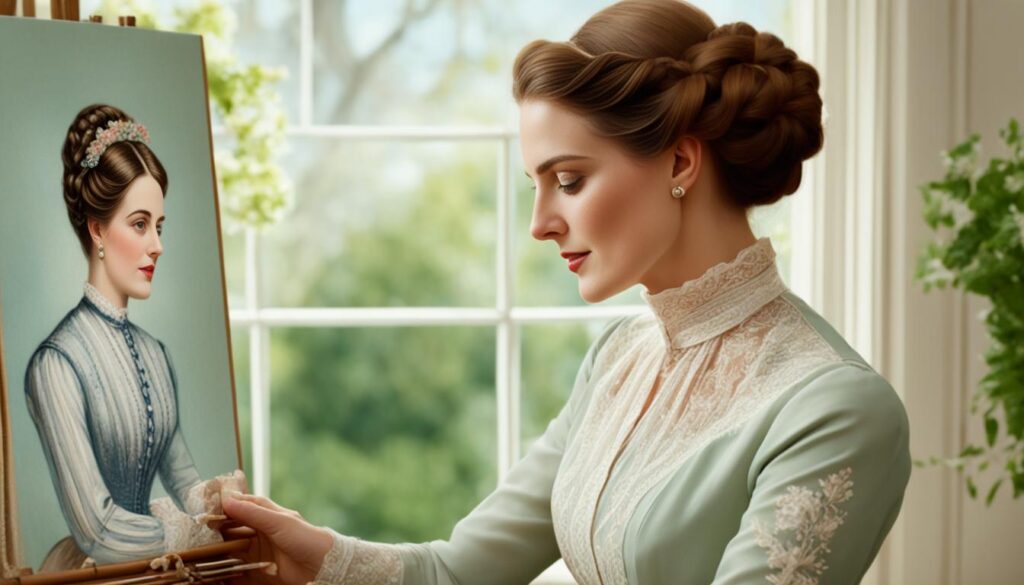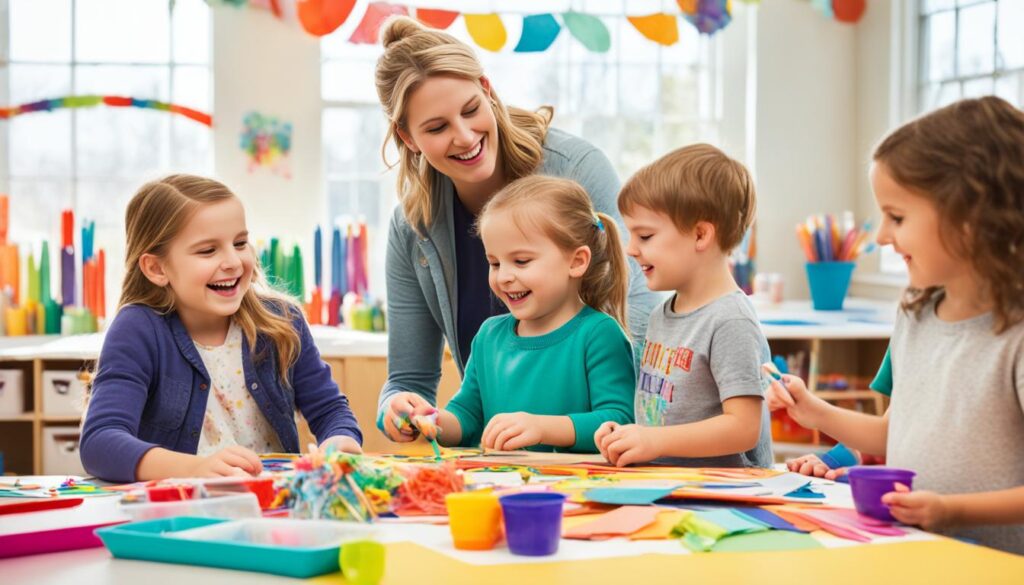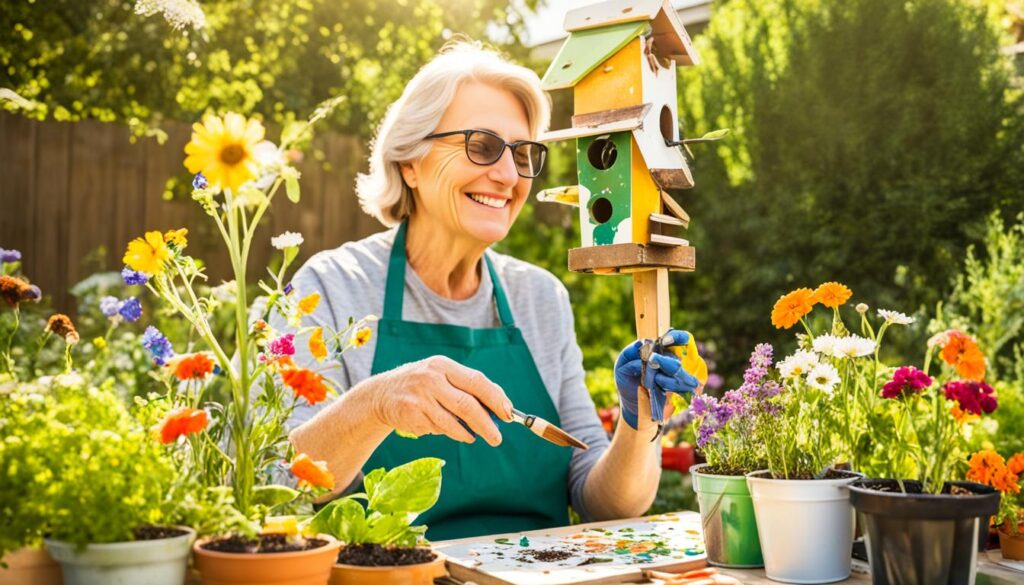Welcome to our blog post on sustainable hobbies inspired by Victorian era crafts. In this article, we will explore various eco-friendly activities and upcycling projects that Victorians enjoyed, ranging from indoor and outdoor gardening to sustainable DIY crafts. By embracing these sustainable hobbies, we can not only express our creativity but also contribute to a more environmentally conscious and fulfilling way of living.
Key Takeaways:
- Victorian crafts offered a way for people to engage in practical and inexpensive hobbies using sustainable materials found in their homes or nature.
- Natural materials such as moss, shells, and wood were commonly used in Victorian crafts, allowing individuals to bring the beauty of nature into their homes.
- Hair work was a popular Victorian craft, used to create handmade gifts and preserve memories.
- Wyndham’s Green Living Series promotes sustainable living and offers workshops and events focused on eco-friendly activities.
- DIY crafts for kids provide a fun and eco-friendly way to encourage creativity and create personalized gifts.
Victorian Crafts Using Natural Materials
In the Victorian era, craft enthusiasts embraced the use of natural materials to create stunning art objects and pictures. These crafts allowed them to bring the beauty of nature into their homes while staying true to their sustainable values.
One popular Victorian craft was shell craft, where shells were carefully fashioned into intricate floral pictures. The delicate designs and vibrant colors of these shell creations added elegance to any room. Additionally, beads made from rose petals were used to create unique necklaces and rosaries, showcasing the Victorians’ ingenuity in repurposing natural materials.
Moss craft was another beloved Victorian hobby. People would collect various types of moss and arrange them creatively to construct miniature landscapes or decorative objects. This meticulous craft brought a touch of greenery and serenity into Victorian homes.
Examples of Victorian Crafts Using Natural Materials
“The Victorians were known for their creativity and resourcefulness, and their mastery of crafts using natural materials truly reflects their ingenuity.”
To gain a deeper understanding of Victorian crafts using natural materials, let’s take a look at some examples:
| Victorian Craft | Natural Materials |
|---|---|
| Shell Craft Floral Pictures | Shells |
| Rose Petal Beads | Rose petals |
| Moss Craft | Moss |
The table above illustrates the various types of Victorian crafts and the natural materials used to bring them to life. By harnessing nature’s offerings, the Victorians were able to create intricate and beautiful pieces that have stood the test of time.
Continue reading to discover more about other fascinating Victorian crafts and how they inspire a sustainable and creative way of life.
The Art of Hair Work in the Victorian Era
Hair work was a popular Victorian craft that allowed individuals to create unique and handmade gifts while preserving cherished memories. Using creativity and craftsmanship, Victorians fashioned hair into intricate designs, such as flower-like hair wreaths and custom frames for photographs.
Special techniques were employed to create a variety of patterns and shapes using hair. These exquisite pieces were often displayed in decorative glass cases, showcasing both the artistry and sentimental value of hair work.
“Hair work enabled Victorians to express their creativity and craftsmanship while creating personalized gifts that were truly one-of-a-kind.”
Preserving Memories and Creating Handmade Gifts
The art of hair work served as a means to preserve memories and pay tribute to loved ones. By incorporating hair into their craft, Victorians could create lasting mementos that held sentimental value.
Handmade gifts created through hair work were treasured for their personal touch and attention to detail. These unique pieces became cherished heirlooms passed down through generations, carrying with them the memories and stories of loved ones long gone.
In addition to being a meaningful craft, hair work allowed Victorians to explore their creativity and showcase their craftsmanship. The process of fashioning intricate designs using hair required skill and patience, making it a true art form.
The art of hair work was not limited to just personal use. It also became a popular trend for creating jewelry, such as lockets and brooches, featuring delicate hair designs. These jewelry pieces served as both fashionable accessories and tangible connections to loved ones.
Beauty and Craftsmanship
Victorians valued beauty and craftsmanship in their creations, and hair work was no exception. The intricate designs and attention to detail in hair wreaths and frames displayed the dedication and skill of the craftsman.
To further enhance the aesthetic appeal, the hair was often combined with other materials such as pearls, gemstones, or ribbons. The result was a stunning piece of art that showcased the creativity and craftsmanship of the Victorian era.

| Key Features of Hair Work in the Victorian Era | Benefits |
|---|---|
| Creation of intricate designs | Offers a unique and personalized gift |
| Preservation of cherished memories | Serves as a tangible connection to loved ones |
| Combination of hair with other materials | Enhances the aesthetic appeal and beauty |
| Displayed in decorative glass cases | Showcases the artistry and craftsmanship |
Wyndham’s Green Living Series: Embracing Sustainable Hobbies Today
At Wyndham’s Green Living Series, we are passionate about promoting sustainable living and empowering individuals to adopt eco-friendly activities. Our annual event offers a diverse range of workshops and events that focus on sustainable living, equipping participants with the knowledge and skills to lead greener lives.
As part of the Resilient Wyndham Strategy, our Green Living Series aims to make the community more resilient in the face of potential future events such as climate change and natural disasters. We believe that embracing sustainable hobbies is a key aspect of building a resilient community.
Join Us for Sustainable Living Workshops
Our Green Living Series features a mix of virtual and physical events throughout the year. We offer a variety of sustainable living workshops, covering topics such as gardening, upcycling, DIY crafts, and eco-friendly activities.
By participating in our sustainable living workshops, you will gain valuable insights and practical tips for integrating sustainable practices into your daily life.
Whether you are a beginner looking to embark on a new eco-friendly hobby or a seasoned enthusiast seeking to expand your knowledge, our workshops cater to all levels of experience.
Embrace Eco-Friendly Activities
In addition to workshops, the Green Living Series provides an opportunity to engage in eco-friendly activities that promote sustainable living. From community clean-up initiatives to sustainable arts and crafts projects, there is something for everyone.
Join us in making a positive impact on the environment and building a future that is both sustainable and resilient.
By participating in our eco-friendly activities, you can have fun while contributing to the well-being of our planet.
Join us at Wyndham’s Green Living Series and be part of a community that embraces sustainable hobbies and eco-friendly practices. Together, we can create a more resilient and sustainable future for Wyndham.
DIY Crafts for Kids: Fun and Eco-Friendly Gift Ideas
Encouraging creativity and providing kids with fun and eco-friendly gift ideas, DIY crafts are a fantastic way to keep children engaged and entertained. Not only do these crafts cut costs, but they also stimulate brain activity and promote the development of creativity. Kids can explore their artistic side while using sustainable materials and creating personalized gifts for their loved ones.
Simple Craft Ideas for Kids
- Decorating photo frames: Let your child unleash their imagination by decorating plain photo frames with paint, glitter, and various embellishments.
- Making coasters: Using recycled materials such as cardboard or cork, kids can create their own unique coasters by painting or adding decorative paper.
- Creating pincushions: Teach your child sewing skills by guiding them through the process of making their own pincushions using fabric scraps and stuffing.
- Painting wooden plaques: Allow your child to express themselves and practice their painting skills by decorating wooden plaques with vibrant colors and patterns.
- Crafting flower clocks: Combine creativity and learning by making flower clocks using simple materials like construction paper, markers, and a clock mechanism.
These DIY projects not only provide hours of entertainment but also boost children’s self-esteem and foster their artistic abilities. By reusing and repurposing materials, kids learn the importance of sustainability and develop a sense of responsibility towards the environment.
“DIY crafts engage children’s imagination and creativity while introducing them to the concept of eco-friendly practices.”
Engaging in DIY crafts for kids also offers a meaningful opportunity for parents and guardians to bond with their children, creating lasting memories and fostering a love for hands-on activities. Whether it’s a rainy day indoors or a sunny afternoon in the garden, these eco-friendly crafts keep young minds stimulated and encourage a love for sustainable living.
Homemade Paint Recipe for Kids’ Crafts
When it comes to kids’ crafts, having the right supplies can make all the difference. However, craft supplies can be expensive, especially when it comes to paint. But fear not! We have a solution that is both inexpensive and fun – a homemade paint recipe that will unleash your child’s creativity without breaking the bank.
Making your own paint is not only cost-effective but also allows you to tailor the colors to your child’s preferences. Plus, it’s a great way to incorporate the concept of upcycling and reduce waste by repurposing everyday ingredients.
Gather Your Ingredients
To make your homemade paint, you’ll need some basic ingredients that you probably already have in your pantry:
- Flour: 1 cup
- Salt: 1 cup
- Water: 1 cup
- Food coloring: a few drops of your chosen colors
That’s it! With just these simple ingredients, you can create vibrant and colorful paint for your child’s crafts.
Mixing the Paint
Creating your homemade paint is as easy as 1, 2, 3:
- In a mixing bowl, combine the flour and salt.
- Add the water gradually while stirring to create a smooth paste. Ensure there are no lumps.
- Divide the mixture into different containers if you want to create multiple colors.
- Add a few drops of food coloring to each container and mix well until you achieve the desired shades.
And there you have it! Your homemade paint is ready to be used in your child’s artistic endeavors.
Using the Paint
Now that you have your homemade paint, it’s time to let your child’s creativity shine. Repurpose old condiment squeeze bottles as convenient and mess-free containers for the paint. This way, your child can easily control the flow and create beautiful masterpieces without worrying about spills or messes.
Encourage your child to explore different painting techniques, such as finger painting, sponge painting, or using brushes, to unleash their imagination and create colorful works of art.
The Benefits of Homemade Paint
Making your own paint has many advantages beyond the cost savings. By creating DIY paint, you are teaching your child about resourcefulness, upcycling, and reducing waste. It’s a valuable lesson in sustainability that will instill lifelong habits.
Additionally, using homemade paint allows you to control the ingredients, making it a safer option for young children who may be prone to putting things in their mouths. With this recipe, you can be confident that your child is using non-toxic materials in their artistic endeavors.
Craft Parties for Kids: Easy Cleanup and Creativity
Craft parties for kids are a popular choice, providing an opportunity for children to engage in creative activities while having fun. At our craft parties, we prioritize easy cleanup and encourage children’s creativity through personalized craft projects.
One of our favorite ideas is using large letters of each child’s name as a craft project. Kids can decorate their initials with stickers, paints, glitter, paper, and other embellishments. This not only promotes creativity but also allows children to have personalized gifts to take home.
For effortless cleanup, we recommend using a plastic tablecloth. After the craft session, simply gather the corners of the tablecloth and discard it. This saves time and ensures that the party area stays tidy and organized.
Our craft parties promote creativity and provide an enjoyable experience for both children and parents. By providing plenty of inexpensive supplies and encouraging children to explore their imagination, we create an environment that sparks joy and fosters artistic expression.
Join us for an unforgettable craft party where your child can unleash their creativity and take home their own personalized masterpiece!

Craft Party Supplies
| Supplies | Description |
|---|---|
| Stickers | A wide variety of colorful and themed stickers. |
| Paints | Non-toxic paints in various colors. |
| Glitter | Sparkling glitter for extra flair in crafts. |
| Paper | Different types of paper for drawing, cutting, and decorating. |
| Embellishments | Ribbons, beads, sequins, and other decorative items. |
Teaching Fractions and Time with Crafts
Crafts can be valuable educational tools for teaching children important concepts like fractions and time. By engaging in hands-on activities, children can better understand these topics in a visual and interactive way.
Teaching Fractions with Pool Noodles
Pool noodles, those colorful cylindrical foam tubes often used for swimming, can serve as excellent tools for teaching fractions. By cutting pool noodles into different lengths, children can visually represent and compare fractions in a tangible manner. For example, a whole pool noodle can be divided into halves, thirds, or even smaller fractions.
Here’s an example of how pool noodles can be used to teach fractions:
| Pool Noodle Length | Fraction |
|---|---|
| 30 cm | 1/2 |
| 20 cm | 1/3 |
| 10 cm | 1/6 |
Using pool noodles as a visual aid, children can better understand the concept of fractions and how different fractions relate to one another. This hands-on approach encourages active learning and helps solidify mathematical concepts in their minds.
Teaching Time with Flower Clocks
Crafting flower clocks provides a fun and creative way for children to learn how to tell time. By creating a clock face using craft paper and attaching paper petals to represent the hours, children can visually comprehend the concept of time and its measurement.
With the flower clock, children can practice reading and setting the time by aligning the paper petals with the corresponding hour. This interactive activity enhances their understanding of the relationship between the position of the hour hand and the passage of time.
By utilizing crafts as teaching tools, children can engage in enjoyable activities while developing a solid foundation in fractions and time. These hands-on experiences make learning more memorable and promote a deeper understanding of these essential concepts.
Conclusion
Sustainable hobbies have been an integral part of human history, and the Victorians serve as a remarkable example of how people in the past embraced eco-friendly activities. Through the use of natural materials like shells and moss, as well as engaging in hair work and DIY crafts, the Victorians found ways to express their creativity while living a greener lifestyle.
By exploring and adopting these Victorian-era hobbies today, we can contribute to a more environmentally conscious and fulfilling way of living. Whether it’s cultivating a beautiful garden, creating DIY crafts using sustainable materials, or even preserving cherished memories through the art of hair work, these activities offer us the opportunity to reconnect with nature, express our creativity, and make a positive impact on the planet.
As we incorporate sustainable practices into our modern lives, we can derive not only personal satisfaction but also play a part in building a sustainable future for generations to come. Embracing sustainable hobbies such as gardening, DIY crafts, and other eco-friendly activities allows us to make a tangible difference, reduce waste, and live more harmoniously with the environment. Let us take inspiration from the Victorians and commit to a greener and more sustainable lifestyle.
FAQ
What were some popular Victorian crafts?
Some popular Victorian crafts included shell craft bouquets, candle making, and silhouette portraits.
What materials did Victorians use in their crafts?
Victorians often used natural materials like moss, shells, seeds, wood, and even human hair in their craft projects.
What is hair work?
Hair work was a popular Victorian craft that involved fashioning hair into intricate designs, such as flower-like hair wreaths and custom frames for photographs.
What is the Wyndham’s Green Living Series?
Wyndham’s Green Living Series is an annual event that promotes sustainable living and offers workshops and events focused on eco-friendly activities.
What are some eco-friendly DIY craft ideas for kids?
Some eco-friendly DIY craft ideas for kids include decorating photo frames, making coasters, creating pincushions, painting wooden plaques, and crafting flower clocks.
How can I make homemade paint for kids’ crafts?
You can make homemade paint using ingredients like flour, salt, water, and food coloring. It’s an inexpensive and colorful alternative to store-bought paint.
How can I organize a craft party for kids with easy cleanup?
To organize a craft party for kids with easy cleanup, use large letters of each child’s name as a personalized craft project and provide plenty of stickers, paints, glitter, and paper. Use a plastic tablecloth for easy cleanup.
How can crafts be used to teach children?
Crafts can be used as educational tools to teach children important concepts like fractions and time. For example, pool noodles can be cut into portions to teach fractions, and creating flower clocks can help children learn how to tell time.
